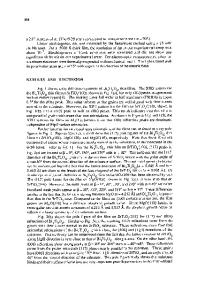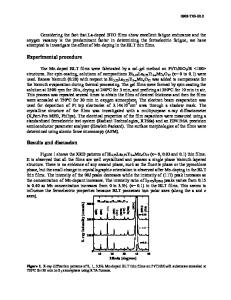Characterization of Ferroelectric Properties of Bi 4-x Pr x Ti 3 O 12 Polycrystals
- PDF / 1,576,166 Bytes
- 6 Pages / 612 x 792 pts (letter) Page_size
- 46 Downloads / 391 Views
0966-T07-09
Characterization of Ferroelectric Properties of Bi4-xPrxTi3O12 Polycrystals Abril Munro1,2, Jorge Mata2, Eduardo Martínez2,3, and Jesus Siqueiros2 1 Postgrado en Física de Materiales, CICESE-CCMC, Centro de Investigación Científica y Estudios Superiores de Ensenada, Apdo. Postal 2732, Ensenada, Baja California, 22860, Mexico 2 Centro de Ciencias de la Materia Condensada, Universidad Nacional Autónoma de México, Apdo. Postal 2681, Ensenada, Baja California, 22800, Mexico 3 Centro de Investigación en Materiales, DIP-CUCEI, Universidad de Guadalajara, Apartado Postal 2-638, Guadalajara, Jalisco, 44281, Mexico
ABSTRACT Effects of Praseodymium doping on the ferroelectric properties of Bi4Ti3O12 using dense ceramics was systematically investigated from room temperature to 730 °C. DRX and XPS studies shows that structure can accept only 10% of praseodymium without the precipitation of second phases. Thermoelectric analysis and ferroelectric hysteresis measurements were performed and show that the incorporation of praseodymium modified the transition temperature Tc and slightly the polarization values. The incorporation of praseodymium resulted in a variation in the permittivity and in the remnant polarization (2Pr). The polarization characteristics in the samples doping were different to Bi4Ti3O12. INTRODUCTION Recently, Bi4Ti3O12 (BIT) has attracted much attention for potential utilization in thin films for NvRAMs due to its large spontaneous polarization (Ps), high breakdown strength, high dielectric constant, high Curie temperature (675oC) with the remnant polarization Pr being around 50 µC/cm2 along the a axis [1]. BIT is a typical layered-structure of the Aurivillius family with m=3. In the crystals perovskite blocks (Bi2Ti3O10)2- three TiO6-octahedral layers with Ti4+ ions are surrounded by oxygen octahedra, and Bi3+ ions occupy the outside TiO6 octahedra. Bi at the A site are interleaved with Bi2O2 layers along the c-axis [2,3]. At room temperature, the structure is orthorhombic of the space group B2cb and it continuously transforms to the hightemperature tetragonal I4/mmm structure via an intermediate orthorhombic phase. [3-4]. In the last years, the study of BIT has been intensified dramatically, thin films of lanthanum-substituted BIT (Bi3.25La0.75Ti3O12) were reported to have a relatively large 2Pr of 24 µC/cm2 becoming a promising alternative for FRAM applications [1,5-6]. It is commonly known that proper element doping at the A-site with rare earth elements or B-site with V, Ta, Nb or W ion in the perovskite-type unit of BIT can effectively optimize the ferroelectric properties [6]. Moreover Noguchi et al. reported a pronounced enhancement of remnant polarization on doped BIT with a V ion at site B [7]. Praseodymium doping into BIT causes a large shift of the Curie temperature (Tc) of pure BIT from 675 to 400 0C [8-10]. The objective of this work is to report the study and the electrical characterization of BIT ceramics doped with Praseodymium, as well the influence of this doping in the ferroele
Data Loading...











